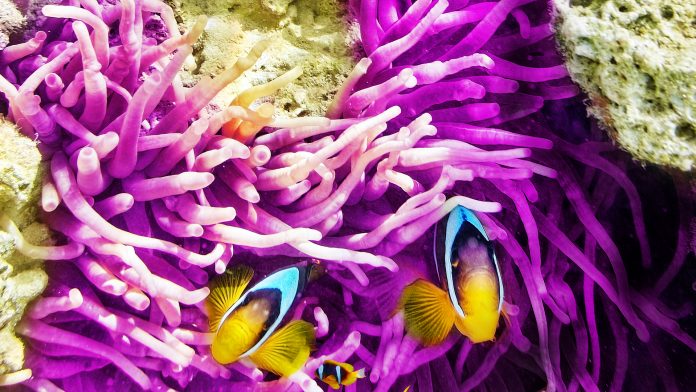Sea4Us is a pharmaceutical company working on the discovery and development of drugs active on ion channels involved in syndromes, such as chronic pain.
Living beings on our planet have evolved over millions of years, leading to the development of countless molecules, most of which are yet to be explored and have enormous bioactive potential. Marine compounds and venoms are a treasure trove of active principles that could potentially provide a treasure trove of different cures.
Hundreds of species of marine invertebrates (such as marine sponges, anemones, and starfish) coexist in an immense diversity. Each of these organisms contain hundreds of different natural compounds, many of which are designed for ecological competition and to avoid predators. In their majority, such properties can be used for potential cures for diseases. This is because within such enormous diversity lies a chemical uniqueness that goes well beyond the reach of human knowledge. The aforementioned is ground for the concept of Sea4Us – a pharmaceutical company that is currently developing a treatment for chronic pain. This includes the development of two molecules of marine origin, and a novel/revolutionary mechanism of action.
Chronic pain is a global problem affecting 21% of the world’s population and causes a great loss in the quality of life for those that suffer from it. The drug being developed by Sea4Us has a product profile that constitutes as an alternative to opioids. Chronic pain can derive from several clinical conditions, such as diabetes, arthritis, migraines, fibromyalgia, and cancer. It can cause disability, which can lead to an enormous social and economic burden, With similar figures in Europe, the USA annually loses over $635b (~€581b) as a result of salary losses, low productivity and health care costs.

Ionic current-component results
At Sea4Us, research on the underlying physiological mechanisms of chronic pain have focused on the ion channels and currents that are protagonists in chronic and acute pain and are at the periphery on the nociceptive neurons (mainly on c-fibres). Using patch- and current-clamp approaches, an extensive survey has been conducted at the Sea4Us’s laboratory to identify the specific and shared biophysical patterns of K+ and Na+ currents from fibres obtained from the dorsal root ganglia (DRG) and trigeminal ganglia (TG) of several pain models, in comparison with control, uninjured neurons. Results on ionic current-components have been dissected and those that show an altered functional expression in each type of pain model have been cross-associated with behavioural efficacy tests. This established grounds for a search on the molecular correlates of such abnormally expressed current components.
By characterising the biophysical nature of what is functionally altered in ionic currents of given nociceptive neurons from pain models, Sea4Us can design the mode-of-action of a ‘wonder drug”’ that should shift back to control ‘normal’ biophysical patterns. As a result, the modulation effects envisaged for the ‘wonder drug’ must be specific on certain ion channel gating modes. This underlies the new mechanism of action identified by Sea4Us. Intimately related to the value of this mode-of-action is the fact that the compound binds to the channel/target only when it is in a given state that requires channel activity. Such activity-dependent modulation dictates the specific in vivo data, showing that the compound-induced nociceptive scores are only altered (reduced) in the limbs/paws/face-sides that are injured and in pain. On those uninjured, such as on control animals, there are no effects shown at all.
Sea4Us’s analgesic molecules, which act through this novel mechanism of action, are effective in suppressing hyperexcitability as well as in restoring basal levels of activity with consequent reduction of pain but without affecting ‘painless’ neurons. The uniqueness of this analgesic effect relies on the fact that the compounds will only act on the fibres/nerves that are affected by the pain condition.
Marine substances give an outstanding advantage

The two already identified analgesic compounds modulate specific potassium (K+) channels in c-fibre pain-sensing neurons (specific Kv). Such modulation of K+ channel activity in pain-sensing neurons are proposed in order to prevent brain perception of pain and brain-derived limiting side effects. As a result, the Sea4Us’s novel approach will give rise to a new class of pharmaceutical drugs with no expected adverse effects on the brain. The Kv channel type targeted by Sea4Us’s compounds is located in efferent axons of the neurons, whose cell bodies are located at the nervous ganglia outside the spinal cord (DRG) and outside the brain (TG), involved in the physiological pathway that leads to the brain’s perception of pain. By ‘switching off’ such ganglia, which are pain processors, the Sea4Us’s compounds prevent brain perception of pain in a way that does not affect brain functioning.
Sea4Us has already performed successful efficacy proof-of-concept studies in different chronic pain rat models such as post-operative pain, inflammatory pain, orofacial pain (trigeminal neuralgia), painful diabetic neuropathy, chemotherapy-induced peripheral neuropathy, and visceral pain, with no signs of toxicity. Now, lead optimisation is being ultimate with preclinical tests entering an exciting stage.
Working on marine substances gives an outstanding advantage that enables the access to ingenious and out-of-the-box molecular structures. For Sea4Us, this is a main part of its DNA – the marine nature is the source of the inspiration, whereas biotechnology refines evolution genius. This strategy also matches key parts of Sea4Us’s mission in terms of being a sustainable manner of exploring the oceans and biodiversity. Even if some of these molecules are difficult to elucidate and synthesise, Sea4Us has been lucky with the choices made: two analgesic molecules present in marine invertebrates have been fully elucidated and were found to be chemically synthesisable. More of these molecules are now being further improved by medicinal chemistry in order to match optimal drug performances.
What do you know about Sea4Us?
Sea4Us has developed a platform focused on drug discovery and development of novel pharmaceuticals based on core expertise in ion channels and marine biology. Sea4Us’s mission is to develop novel pharmaceutical drugs from marine living organisms for untreated human disorders. Sea4Us screens marine compounds against several ion channels (such as Nav, Kv and Cav), which are involved in numerous pathologies. Therefore, the companies activities are focused on studying marine-living organisms’ compounds bioactivities, consequent biotechnological production or artificial chemical synthesis of bioactive pure compounds, and pharmaceutical development including non-clinical and early clinical trials, before out-licensing the generated intellectual property to larger pharmaceutical companies that will then continue drug development.**
Pedro Lima
CEO, CSO and Co-Founder
Sea4Us
+351 21 880 3078
info@sea4us.com
Linkedin
http://sea4us.pt/
Please note, this article will also appear in the first edition of our quarterly publication, the Innovation Platform.







